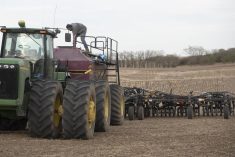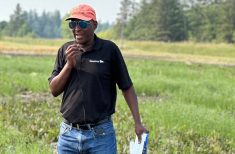Widespread adoption of voluntary protocols for balancing soil fertility requirements with the need to protect surface water quality will be far more effective than legislation, the director of the International Plant Nutrition Institute says.
Tom Jensen told the recent Manitoba Soil Science Society’s annual conference farmers can maintain crop yields and minimize adverse environmental effects by following the four Rs — right source, right rate, right time and right place.
“If we follow the principles of the four Rs, and apply them to the area, we can often do a better job than if we had to follow legislation,” Jensen told the conference.
Read Also

Still hard to predict precise fertilizer payback
Despite decades of advances, international research finds no clear answer for where and when adding nutrient will fail to boost growth.
Sticking to the four main principles is a way of showing the public that farmers are mindful of their impact on the landscape, and it helps fend off criticism that could lead to onerous regulation, he added.
“Basing your nutrient management on principles gives you some flexibility to be creative,” said Jensen.
It’s not just about Lake Winnipeg. For example, in the Lake Erie area, where the lake is turning an eerie green at an alarming rate, farmers have been watching the weather forecast more closely to ensure that the timing of broadcast phosphorus applications is done a few days ahead of major rainfall events.
Near Chesapeake Bay in Maryland state, farmers are also timing applications better while switching to various fertilizer banding methods to prevent nutrient loading, he added.
Stewardship awards
To encourage more adoption of the four Rs, the IPNI, farm groups and state governments have created stewardship awards for farmers and retailers and developed educational videos to spread the message.
But what is the “right” way of doing things, and who decides?
The bottom line, said Don Flaten, a soil science professor at the University of Manitoba, is that “banding is better” for nitrogen, phosphorus and potash, but elemental sulphur needs to be surface broadcast well in advance of the growing season.
Farmers have a huge array of options and strategies for feeding crops. As proof, Flaten held up a hefty copy of what soil scientists call the “Red Book.” At 527 pages and first published in 1993, it summarizes the collected insights gleaned from 75 years of nutrient management in Western Canada.
While there may be no single best combination of the four Rs for a particular situation, some are obviously poorer choices than others.
From the Grainews website: Planning ahead for fertility
“We do not recommend using the source, anhydrous ammonia, with the placement method of broadcast. It’s not a good idea to broadcast a gas, right?” said Flaten, with a smile.
There’s no one-size-fits-all fertilization system because every farm field and year has unique demands, resources and conditions.
However, matching rates to crop requirements and removal rates, and using a combination of placement, timing and source that maximizes chemical availability while minimizing losses, is the key to success and staying out of trouble, he said.
What if the source happens to be manure?
It annoys Kathy Buckley, an Agriculture and Agri-Food Canada soil scientist based in Brandon, whenever she sees the acronym “FYM” used to describe agriculture’s most valuable byproduct.
“Farm Yard Manure,” a catch-all term used in scientific literature, does a poor job of characterizing a substance in chemical terms that could be from multiple species or processed in a variety of ways that could change its properties dramatically.
“It makes it a whole different ball game when you’re trying to use them in agronomic systems,” said Buckley.
Different ball game
Aside from that, “right” timing of application is a big issue when trying to move thousands of tons of a bulky product across the landscape, she said, noting that the provincial government’s guidelines for fall and spring windows for application don’t always mesh with the weather or soil conditions.
“Spring application is very, very difficult,” she said. “If you have a heavy manure tanker, it’s wonderful to get out on frozen soil because you’re not compacting it.”
Phosphorus loading from heavy rates of manure, is the “gift that keeps on giving,” she added.
Her own studies, and those of others, show that attempts to “mine” the nutrient out of soils with annual and perennial cropping are slow to show results, even after a decade.
“It’s going to be a long endeavour, so don’t put it there in the first place,” said Buckley.















